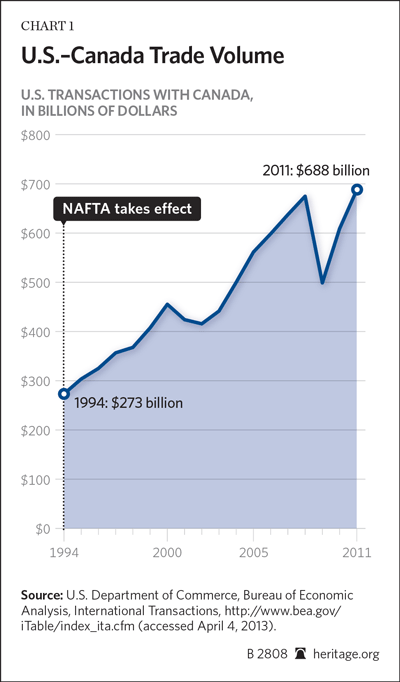U.S.-Canada Trade: Separating Fact From Fiction In Trump's Assertions

Table of Contents
Debunking the Myth of Unfair Trade Practices
The narrative of unfair trade practices between the U.S. and Canada has frequently been deployed in political discourse. Let's examine the evidence.
Analyzing Claims of Trade Deficits
One common claim centers on trade deficits. A trade deficit occurs when a country imports more goods and services than it exports. While the U.S. has often had a trade deficit with Canada, this metric alone doesn't indicate unfair trade practices.
- Trade deficits are complex: They are influenced by various factors, including exchange rates, consumer demand, production costs, and the overall global economic climate. Focusing solely on the deficit ignores the intricate web of economic interactions.
- Bilateral trade is misleading: Focusing on bilateral trade balances can be deceptive. Goods may transit through multiple countries before reaching their final destination, making accurate tracking difficult.
- Trade deficits don't always mean economic harm: Even with a deficit, both countries benefit from specialized production and trade. Canada may export raw materials to the U.S., while the U.S. exports manufactured goods to Canada, resulting in mutual economic gains.
For detailed data, consult resources like the U.S. Census Bureau () and Statistics Canada ().
Addressing Allegations of Currency Manipulation
Another common accusation is that Canada manipulates its currency to gain an unfair trade advantage. This claim lacks credible evidence.
- Exchange rates are complex: Numerous factors influence exchange rates, including interest rates, inflation, market sentiment, and global economic conditions. Central banks have limited control over these fluctuating factors.
- No evidence of manipulation: Economic studies have found little to no evidence supporting claims of Canadian currency manipulation for trade advantage.
- Central bank objectives: Central banks primarily focus on maintaining price stability and promoting sustainable economic growth, not manipulating exchange rates for trade gains.
The Reality of Integrated Supply Chains
The U.S. and Canadian economies are deeply intertwined, with extensive cross-border supply chains. This integration is a hallmark of the U.S.-Canada trade relationship.
Examining the Automotive Industry's Interdependence
The automotive sector exemplifies this interconnectedness. U.S. and Canadian automakers share parts production, assembly plants, and distribution networks, creating a highly integrated system.
- Cross-border production: Many vehicles are assembled in one country using parts sourced from the other, resulting in shared value creation and economic growth.
- Disruption's consequences: Severing these integrated supply chains would have severe economic consequences, leading to job losses and disruptions in production on both sides of the border.
Beyond Autos: Interconnectedness Across Sectors
The integrated nature of U.S.-Canada trade goes beyond the automotive sector:
- Energy: Canada is a major energy supplier to the U.S., providing significant amounts of oil and natural gas.
- Agriculture: Both countries trade extensively in agricultural products, creating mutual benefits for farmers and consumers.
- Technology: Close collaboration exists in the tech sector, with significant cross-border investments and joint projects.
The Impact of Protectionist Policies on U.S.-Canada Trade
Protectionist policies, such as tariffs and trade barriers, can severely disrupt the smooth flow of U.S.-Canada trade.
Analyzing the Economic Consequences of Tariffs and Trade Barriers
Tariffs increase the cost of imported goods, impacting consumers, businesses, and overall economic growth.
- Higher prices for consumers: Tariffs lead to higher prices for consumers, reducing purchasing power.
- Reduced competitiveness for businesses: Tariffs can make U.S. businesses less competitive in the global market.
- Potential job losses: Protectionist policies can lead to job losses in both countries, as trade flows are disrupted.
The Importance of Free Trade Agreements
Free trade agreements, such as the United States-Mexico-Canada Agreement (USMCA), are crucial for facilitating trade and economic growth.
- USMCA benefits: The USMCA significantly reduces trade barriers and promotes economic integration between the three countries.
- Reduced uncertainty: Stable trade agreements provide certainty for businesses and investors, fostering economic growth and job creation.
Conclusion
Claims of unfair trade practices between the U.S. and Canada often oversimplify the complexities of bilateral trade. The reality is that the two countries have deeply integrated economies, with extensive cross-border supply chains and mutual economic benefits. Focusing solely on trade deficits or accusing currency manipulation overlooks the bigger picture. Protectionist policies risk disrupting this crucial economic relationship, leading to negative consequences for both countries. Understanding the complexities of U.S.-Canada trade requires critical evaluation of all information sources. Seek out reliable data to form your own informed opinion on the future of U.S.-Canada trade relations and the importance of maintaining strong bilateral U.S.-Canada trade.

Featured Posts
-
 Ufc 314 Paddy Pimblett Addresses Criticism After Beating Michael Chandler
May 15, 2025
Ufc 314 Paddy Pimblett Addresses Criticism After Beating Michael Chandler
May 15, 2025 -
 Bvg Tarifkonflikt Beendet Details Zum Abschluss Der Verhandlungen
May 15, 2025
Bvg Tarifkonflikt Beendet Details Zum Abschluss Der Verhandlungen
May 15, 2025 -
 Analyzing The Earthquakes Loss To The Rapids Steffens Impact
May 15, 2025
Analyzing The Earthquakes Loss To The Rapids Steffens Impact
May 15, 2025 -
 Ver Roma Monza En Directo Minuto A Minuto
May 15, 2025
Ver Roma Monza En Directo Minuto A Minuto
May 15, 2025 -
 Steam Free Game Download And Review Analysis
May 15, 2025
Steam Free Game Download And Review Analysis
May 15, 2025
